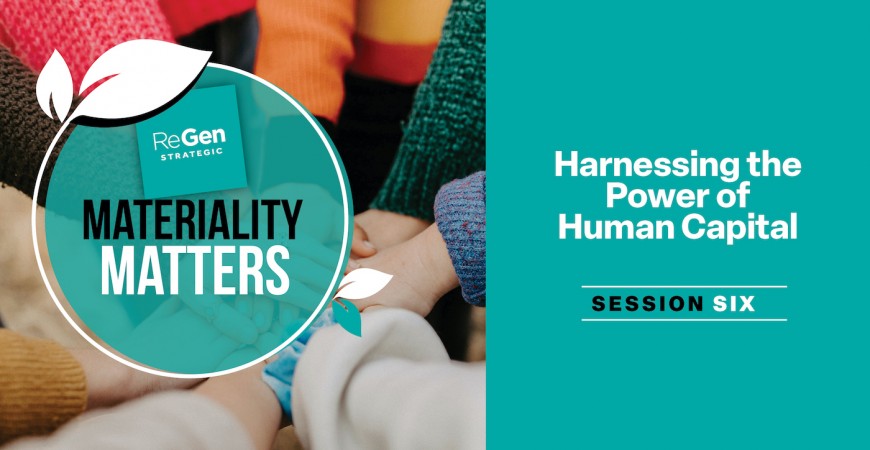In today's fast-paced business world, the real game-changer isn't just the latest tech or a slick marketing campaign – it's people. Yes, the collective talent, creativity, and skills of your team are what truly set your company apart. This is what we call human capital and investing in it is essential for long-term success.
Integrating human capital into sustainability strategy is essential for fostering a resilient and forward-thinking organisation. By prioritising employee development, companies can drive innovation and improve operational efficiency. Supporting the well-being of the workforce enhances job satisfaction and retention, which in turn reduces costs and preserves valuable institutional knowledge. Additionally, promoting diversity and inclusion within the workplace encourages a culture of creativity and adaptability. A robust focus on human capital ensures that the organisation is equipped to meet both current and future sustainability challenges effectively.
But, what exactly is “Human Capital”?
Think of human capital as the sum of your workforce's skills, knowledge, and experience. It's not just about having people in seats; it's about having the right people, with the right skills, ready to tackle any challenge. From continuous learning to promoting wellness, nurturing human capital means creating an environment where your team can thrive and innovate.
Human capital is crucial because it drives innovation and creativity. Diverse, skilled teams are breeding grounds for new ideas, and when employees feel valued and challenged, they are more likely to produce breakthrough solutions. Additionally, well-trained employees enhance productivity by maintaining sharp, relevant skills.
Investing in human capital also boosts engagement and retention. Satisfied employees are less likely to leave, reducing turnover costs and preserving institutional knowledge. Moreover, a robust human capital strategy builds resilience, enabling adaptable, well-prepared teams to navigate and thrive through challenges and uncertainties.
To assess the financial and sustainability risks of human capital in a materiality assessment, evaluate key areas such as employee turnover rates, training and development costs, and the impact of workplace conditions on productivity and health of your people and the communities in which you operate. Consider the potential financial implications of high turnover, underinvestment in skills, and poor employee well-being. Additionally, examine how diversity, inclusion, and leadership development contribute to long-term sustainability. This comprehensive analysis helps identify areas where strategic investment in human capital can mitigate risks and drive organisational success.
Financial Risks include attrition costs and underperformance. High turnover incurs expenses from recruitment, training, and lost productivity, while inadequate investment in training can result in a less competent workforce, negatively affecting productivity and profitability.
Sustainability Risks which may arise from inadequate investment in human capital include contributing to low job satisfaction, morale, and mental health issues among employees. A lack of training and career development opportunities hinders economic and personal growth, perpetuating social inequality and limiting community prosperity through reduced job opportunities and morale.
Financial Opportunities include cost savings and market competitiveness. Efficient, well-trained employees can reduce operational costs through improved productivity, while a skilled workforce can boost innovation, keeping the company ahead of its competitors.
Sustainability Opportunities include implementing flexible work arrangements, generous PTO policies, wellness programs, and remote work support to enhance employee well-being and productivity. Clear communication, breaks, recognition, training, supportive culture, and EAPs further support work-life balance, fostering a healthier organisational environment. Effective human capital management promotes diversity, ensuring equal opportunities and enhancing social equity. Investing in local talent and offering prosperous job options can strengthen community ties, foster goodwill, and stimulate local economic development.
To invest in human capital, focus on continuous learning by providing regular training to keep skills updated. Support employees' physical and mental health to maintain motivation and productivity. Foster a diverse and inclusive work environment where everyone feels valued. Finally, develop strong leadership programs to prepare future leaders for navigating both opportunities and challenges.
Australia is undergoing significant changes in legislation concerning human capital, with a focus on enhancing workplace conditions and employee rights. The upcoming regulations aim to ensure fair wages, better job security, and improved work-life balance. Key areas include stricter enforcement of fair work standards, increased support for professional development, and more robust protections against workplace discrimination and harassment. These legislative shifts reflect a broader commitment to valuing human capital and fostering a sustainable, equitable work environment.
In a nutshell, investing in human capital is about more than just filling positions - it's about unlocking the potential within your team. By focusing on their development, well-being, and engagement, you're not just building a workforce; you're building a powerhouse of innovation, productivity, and resilience. So, take a good look at your human capital strategy – it might just be the key to your company's next big breakthrough.
ReGen Strategic materiality assessments are delivered through our sustainability & ESG practice. Talk to us today about how we can deliver a bespoke materiality assessment that sets your organisation’s sustainability strategy and ESG reporting up for success.
 ReGen Strategic
ReGen Strategic